Book contents
- Frontmatter
- Contents
- List of figures
- List of tables
- List of contributors
- Acknowledgments
- PART I INTRODUCTION
- PART II REGIONAL ABANDONMENT PROCESSES: ETHNOARCHAEOLOGICAL CASES
- PART III REGIONAL ABANDONMENT PROCESSES: ARCHAEOLOGICAL CASES
- PART IV ABANDONMENT PROCESSES WITHIN SITES: ETHNOARCHAEOLOGICAL CASES
- PART V ABANDONMENT PROCESSES WITHIN SITES: ARCHAEOLOGICAL CASES
- 12 Ceramic analysis as a tool for discovering processes of pueblo abandonment
- 13 Abandonment processes in prehistoric pueblos
- 14 Household abandonment among sedentary Plains societies: behavioral sequences and consequences in the interpretation of the archaeological record
- PART VI CONCLUSIONS
- Index
14 - Household abandonment among sedentary Plains societies: behavioral sequences and consequences in the interpretation of the archaeological record
Published online by Cambridge University Press: 23 May 2010
- Frontmatter
- Contents
- List of figures
- List of tables
- List of contributors
- Acknowledgments
- PART I INTRODUCTION
- PART II REGIONAL ABANDONMENT PROCESSES: ETHNOARCHAEOLOGICAL CASES
- PART III REGIONAL ABANDONMENT PROCESSES: ARCHAEOLOGICAL CASES
- PART IV ABANDONMENT PROCESSES WITHIN SITES: ETHNOARCHAEOLOGICAL CASES
- PART V ABANDONMENT PROCESSES WITHIN SITES: ARCHAEOLOGICAL CASES
- 12 Ceramic analysis as a tool for discovering processes of pueblo abandonment
- 13 Abandonment processes in prehistoric pueblos
- 14 Household abandonment among sedentary Plains societies: behavioral sequences and consequences in the interpretation of the archaeological record
- PART VI CONCLUSIONS
- Index
Summary
Introduction
Since at least the early 1970s, archaeologists have studied abandonment processes and their effect on the archaeological record (Schiffer 1976:88). Initially, concerns were with de facto refuse and curation practices as part of the abandonment process. More recently, archaeology has witnessed an intensification and diversification in the study of this phenomenon. Archaeological investigations have been directed at differences in planned vs. unplanned abandonment (Brooks 1989) and utilization of sites from initial occupation to abandonment (Binford 1982; Stevenson 1982), while ethnoarchaeological research has focused on the nature of the abandonment process (cf. Kent 1988; Stevenson 1985; Tomka 1989).
Three fundamental concepts regarding abandonment have arisen from this research. First, differences can be drawn in the nature of the abandonment process; Tomka (1989) has distinguished between episodic, seasonal, and permanent abandonment. Second, abandonment processes operate at the settlement, aggregate, and individual household level. Third, abandonment activities do not always represent orderly planned events; they may be unplanned because of either natural or cultural forces. These considerations can be viewed as a matrix of abandonment functions (Fig. 14.1)
From another perspective the process of abandonment cannot be viewed as a separate, static event. It is always dynamically linked to other events through a structure of behavioral activities. For example, abandonment of an individual household because of deterioration is usually tied in some fashion to construction of a new residence.
This paper explores household abandonment processes found among sedentary Native American societies in the Great Plains region of the United States.
- Type
- Chapter
- Information
- The Abandonment of Settlements and RegionsEthnoarchaeological and Archaeological Approaches, pp. 178 - 188Publisher: Cambridge University PressPrint publication year: 1993
- 12
- Cited by

